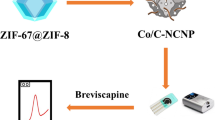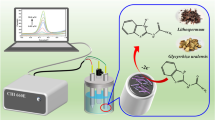Abstract
Baicalin (Bn) is one of the flavonoids with various biological activities, and its accurate determination is of great significance to clinical medicine. The new “MOF-on-MOF” materials have a broad application prospect. ZIF-67 and MIL-101(Fe) are typical metal–organic frame (MOF) materials, which have the advantages of flexible structure, large specific surface area, large porosity, and adjustable pore size. In this paper, a disposable and sensitive Bn electrochemical sensor based on ZIF-67/MIL-101(Fe) composite modified carbon paper (CP) electrode was developed for the first time. The sensing nanomaterials were characterized by scanning electron microscopy (SEM), transmission electron microscopy (TEM), X-ray diffraction spectroscopy (XRD), and X-ray photoelectron spectroscopy (XPS). Cyclic voltammetry (CV) was used to evaluate the electrochemical behavior of Bn on different modified electrodes. The results showed that ZIF-67/MIL-101(Fe)/CP exhibited a well-defined redox peak compared with bare CP, ZIF-67/CP, and MIL-101(Fe)/CP, which was attributed to the synergistic effect of ZIF-67 and MIL-101(Fe). Under optimal conditions, the electrochemical sensor was able to quantify Bn in the ranges of 0.01 ~ 3 µM and 3 ~ 6 µM with a detection limit (LOD) as low as 0.009 µM (S/N = 3). In addition, the sensor was successfully used for the quantitative analysis of Bn in Dual yellow oral liquid with reliable results.










Similar content being viewed by others
Data availability
Data will be made available on request.
References
Song X, Gong Z, Liu K, Kou J, Liu B, Liu K (2020) Baicalin combats glutamate citotoxicity via protecting glutamine synthetase from ROS-induced 20S proteasomal degradation. Redox Biol 34:101559
Xu B, Huang S, Chen Y, Wang Q, Luo S, Li Y, Wang X, Chen J, Luo X, Zhou L (2021) Synergistic effect of combined treatment with baicalin and emodin on DSS-induced colitis in mouse. Phytother Res 35:5708–5719
Zheng Y, Shen D, Ren M, Liu X, Wang Z, Liu Y, Zhang Q, Zhao L, Zhao L, Ma J, Yu B, Liu H (2016) Baicalin, a natural LSD1 inhibitor. Bioorg Chem 69:129–131
Pang H, Wu T, Peng Z, Tan Q, Peng X, Zhan Z, Song L, Wei B (2022) Baicalin induces apoptosis and autophagy in human osteosarcoma cells by increasing ROS to inhibit PI3K/Akt/mTOR, ERK1/2 and β-catenin signaling pathways. J Bone Oncol 33:100415
Jiang X, Jin H, Sun Y, Sun Z, Gui R (2020) Assembly of black phosphorus quantum dots-doped MOF and silver nanoclusters as a versatile enzyme-catalyzed biosensor for solution, flexible substrate and latent fingerprint visual detection of baicalin. Biosens Bioelectron 152:112012
Adin SN, Gupta I, Ahad A, Aqil M, Mujeebet M (2022) A developed high-performance thin-layer chromatography method for the determination of baicalin in Oroxylum indicum L. and its antioxidant activity. J Planar Chromatogr Mod TLC: JPC 35:383–393
Li C, Xu Y (2022) Determination of puerarin, daidzein, baicalin and wogonin in composite preparations by capillary electrophoresis. J Chem Soc Pak 44(4):350–355
Teo CC, Tan SN, Yong JWH, Ong LL (2013) Determination of metabolites from Scutellaria baicalensis by GC/MS and 1H NMR. Anal Lett 46(12)
Liao W, Rui Y (2010) Evaluation of baicalin in Scutellaria baicalensis georgi using HPLC method. Bull Chem Soc Ethiop 24(1):115–119
Winiarski JP, de Melo DJ, Santana ER, Santos CS, de Jesus CG, Fujiwara ST, Wohnrath K, Pessôa CA (2023) Layer-by-layer films of silsesquioxane and nickel (II) tetrasulphophthalocyanine as glucose oxidase platform immobilization: amperometric determination of glucose in kombucha beverages. Chemosensors 11(6):346
Monteiro MC, Winiarski JP, Santana ER, Szpoganicz B, Vieira IC (2023) Ratiometric electrochemical sensor for butralin determination using a quinazoline-engineered prussian blue analogue. Materials 16(3):1024
Torrinha A, Morais S (2021) Electrochemical (bio)sensors based on carbon cloth and CP: an overview. Trends Analyt Chem 142:116324
Luo YF, Ly A, Lahem D, Martin JDM, Romain AC, Zhang C, Debliquy M (2022) Role of cobalt in Co-ZnO nanoflower gas sensors for the detection of low concentration of VOCs. Sens Actuators B: Chem 360:131674
Achmann S, Hagen G, Kita J, Malkowsky IM, Kiener C, Moos R (2009) Metal-organic frameworks for sensing applications in the gas phase. Sensors 9(3):1574–1589
Xu Y, Li Q, Xue H, Pang H (2018) Metal-organic frameworks for direct electrochemical applications. Coord Chem Rev 376:292–318
Li JH, Liu MY, Li Y, Yuan L, Zhang P, Cai Z, Chen H, Zou JL (2021) ZIF-8@ZIF-67–derived ZnCo2O4@nitrogen–doped carbon/carbon nanotubes wrapped by a carbon layer: a stable oxygen reduction catalyst with a competitive strength in acid media. Mater Today Energy 19:100574
Pang W, Gao Y, Hu T, Ma X (2023) A disposable and sensitive sensor based on a ZIF-8@ graphene modified carbon paper electrode for the quantitative determination of luteolin. Anal Methods 15(36):4736–4743
Xu Q, Chen S, Xu J, Duan X, Lu L, Tian Q, Zhang X, Cai Y, Lu X, Rao L, Yu Y (2021) Facile synthesis of hierarchical MXene/ZIF-67/CNTs composite for electrochemical sensing of luteolin. J Electroanal Chem 880(1):114765
Bin Q, Wang M, Wang l (2019) Ag nanoparticles decorated into metal-organic framework (AgNPs/ZIF-8) for electrochemical sensing of chloride ion. Nanotechnology 31:(12)
Dai L, Li Y, Wang Y, Luo X, Wei D, Feng R, Yan T, Ren X, Du B, Wei Q (2019) A prostate-specific antigen electrochemical immunosensor based on PdNPs functionalized electroactive Co-MOF signal amplification strategy. Biosens Bioelectron 132(1):97–104
Shahsavari M, Sheikhshoaie I, Beitollahi H (2022) Electrochemical sensor based on Fe3O4/ZIF-4 nanoparticles for determination of bisphenol A. J Food Meas Charact 17(2):1109–1118
Gao F, Tu X, Ma X, Xie Y, Lu L (2020) NiO@Ni-MOF nanoarrays modified Ti mesh as ultrasensitive electrochemical sensing platform for luteolin detection. Talanta 215:120891
Liu C, Wang J, Wan J, Yu C (2021) MOF-on-MOF hybrids: synthesis and applications. Coord Chem Rev 432:213743
Wang X, Zhuang Y, Shi B (2022) Degradation of trichloroacetic acid by MOFs-templated CoFe/graphene aerogels in peroxymonosulfate activation. Chem Eng J 450:137799
Abdpour S, Kowsari E, Moghadam MRA (2018) Synthesis of MIL-100(Fe)@MIL-53(Fe) as a novel hybrid photocatalyst and evaluation photocatalytic and photoelectrochemical performance under visible light irradiation. J Solid State Chem 262:172–180
Lu M, Deng Y, Li Y, Li T, Wang J (2020) Core-shell MOF@MOF composites for sensitive nonenzymatic glucose sensing in human serum. Anal Chim Acta 1110:35–43
Hu Y, Li W, Wei Z, Yang H, Wang Y, Li S (2023) Advances in electrochemical sensing with ZIF-67 and related materials. Int J Electrochem Sci 18:100180
Ghasempour H, Zarekarizi F, Morsali A (2022) Acyl amide-functionalized and water-stable iron based MOF for rapid and selective dye removal. Cryst Eng Comm 24:4074–4084
Gu A, Wang P, Chen K, Miensah ED, Gong C (2022) Core-shell bimetallic Fe-Co MOFs to activated peroxymonosulfate for efficient degradation of 2-chlorophenol. Sep Purif Technol 298:121461
Wang Y, Wang K, Lin J, Xiao L, Wang X (2020) The preparation of nano-MIL-101(Fe)@chitosan hybrid sponge and its rapid and efficient adsorption to anionic dyes. Int J Biol Macromol 165:2684–2692
Wen D, Ma Y, Mu G, Huang Q, Luo X, Lin D, Xu C, Xie F, Wang G, Guo W (2023) Constructing MIL-53(Fe)@ZIF-67(Co) binary metal–organic framework hierarchical heterostructure electrodes for efficient oxygen evolution. Dalton Trans 52(31):10662–10671
Abel KA, Boyer JC, Andrei CM, Veggel FCJMV (2011) Analysis of the shell thickness distribution on NaYF4/NaGdF4 core/shell nanocrystals by EELS and EDS. J Phys Chem Lett 2(3):185–189
Wu ZL, Sun LP, Zhou Z, Li Q, Huo LH, Huo H (2018) Efficient nonenzymatic H2O2 biosensor based on ZIF-67 MOF derived Co nanoparticles embedded N-doped mesoporous carbon composites. Sens Actuators B: Chem 276:142–149
Jin Y, Mi X, Qian J, Ma N, Dai W (2022) Modular construction of an MIL-101(Fe)@MIL-100(Fe) dual compartment nanoreactor and its boosted photocatalytic activity toward tetracycline toward tetracycline. ACS Appl Mater Interfaces 14:48285–48295
Xu H, Zhu J, Wu X, Cheng Y, Wang D, Cai D (2023) Recognition and quantitative analysis for six phthalate esters (PAEs) through functionalized ZIF-67@Ag nanowires as surface-enhanced Raman scattering substrate. Spectrochim Acta A Mol Biomol Spectrosc 284:121735
Li M, You S, Duan X, Liu Y (2022) Selective formation of reactive oxygen species in peroxymonosulfate activation by metalorganic framework-derived membranes: a defect engineering-dependent study. Appl Catal B 312:121419
Nagaraju G, Chandra Sekhar S, Krishna Bharat L, Yu JS (2017) Wearable fabrics with self-branched bimetallic layered double hydroxide coaxial nanostructures for hybrid Supercapacitors. ACS Nano 11:10860–10874
Gecgel C, Simsek UB, Gozmen B, Turabik M (2019) Comparison of MIL-101 (Fe) and amine-functionalized MIL-101 (Fe) as photocatalysts for the removal of imidacloprid in aqueous solution. J Iran Chem Soc 16(8):1735–1748
Anson FC (1964) Application of potentiostatic current integration to the study of the adsorption of cobalt (III) - (ethylenedinitrilo (tetraacetate)) on mercury electrodes. Anal Chem 36(4):932–934
Chen P, Duan X, Li G, Qiu X, Wang S, Huang Y, Stavitskayac A, Jiang H (2023) Construction of ZIF-67/MIL-88(Fe, Ni) catalysts as a novel platform for efficient overall water splittin. Int J Hydrog Energy 48(20):7170–7180
Laviron E (1974) Adsorption, autoinhibition and autocatalysis in polarography and in linear potential sweep voltammetry. J electroanal chem interfacial electrochem 52(3):355–393
Zhao P, Huang L, Wang H, Wang C, Chen J, Yang P, Ni M, Chen G, Li C, Xie Y, Fei J (2022) An ultrasensitive high-performance baicalin sensor based on C3N4-SWCNTs/reduced graphene oxide/cyclodextrin metal-organic framework nanocomposite. Sens Actuators B: Chem 350:130853
Zhang H, Wang T, Qiu Y, Fu FF, Yu Y (2016) Electrochemical behavior and determination of baicalin on a glassy carbon electrode modified with molybdenum disulfide nano-sheets. J Electroanal Chem 775:286–291
Zhang M, Huang X, Li J, Li Y, Zhao P, Fei J, Xie Y (2023) Ultra-sensitive baicalin electrochemical sensor based on γ-cyclodextrin supramole derived N, Zn double-doped carbon nanosphere. Colloids Surf A: Physicochem Eng Asp 669:131484
Kuzmanović D, Stanković DM, Manojlović D, Kalcher K, Roglić G (2015) Baicalein–main active flavonoid from Scutellaria baicalensis–voltammetric sensing in human samples using boron doped diamond electrode. Diam Relat Mater 58:35–39
Xie Z, Lu W, Yang L, Li G, Ye B (2017) A voltammetry sensor platform for baicalein and baicalin simultaneous detection in vivo based on Ta2O5-Nb2O5@ CTS composite. Talanta 170:358–368
Tang X, Wang H, Yu H, Bui B, Zhang W, Wang S, Chen M, Yuan L, Hu Z, Chen W (2022) Exploration of nitrogen-doped grape peels carbon dots for baicalin detection. Mater Today Phys 22:100576
Funding
This work received financial support from The Key Laboratory Research Foundation of North University of China (No. 2022C80305), the Shanxi Key Laboratory of Advanced Carbon Electrode Materials (No. 202104010910019), and the Shanxi Scholarship Council of China (No. 2022–137).
Author information
Authors and Affiliations
Contributions
YG: conceptualization, methodology, writing—original draft, writing—review and editing. WP: formal analysis, validation. XC: investigation, supervision. ZH: data curation. TH: methodology, visualization. XM: funding acquisition, project administration.
Corresponding author
Ethics declarations
Competing interests
The authors declare no competing interests.
Additional information
Publisher's Note
Springer Nature remains neutral with regard to jurisdictional claims in published maps and institutional affiliations.
Supplementary Information
Below is the link to the electronic supplementary material.
Rights and permissions
Springer Nature or its licensor (e.g. a society or other partner) holds exclusive rights to this article under a publishing agreement with the author(s) or other rightsholder(s); author self-archiving of the accepted manuscript version of this article is solely governed by the terms of such publishing agreement and applicable law.
About this article
Cite this article
Gao, Y., Pang, W., Chang, X. et al. The core–shell structure ZIF-67/MIL-101 (Fe)-modified carbon paper electrode: high sensitivity and selectivity for the determination of baicalin. J Solid State Electrochem (2024). https://doi.org/10.1007/s10008-024-05806-9
Received:
Revised:
Accepted:
Published:
DOI: https://doi.org/10.1007/s10008-024-05806-9




